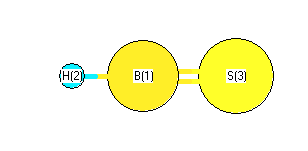Geometric Data

Point Group C∞v
Internal coordinates
distances (r) in Å, angles (a) in degrees, dihedrals (d) in degrees
Cartesians
| Atom |
x (Å) |
y (Å) |
z (Å) |
| B1 |
0.0000 |
0.0000 |
0.0000 |
| H2 |
0.0000 |
0.0000 |
1.1692 |
| S3 |
0.0000 |
0.0000 |
-1.5995 |
Atom - Atom Distances 
Distances in Å
| |
B1 |
H2 |
S3 |
| B1 |
|
1.1692 | 1.5995 |
| H2 |
1.1692 |
|
2.7686 |
| S3 |
1.5995 | 2.7686 |
|
Calculated geometries
for HBS (hydrogen boron sulfide).
Experimental Bond Angles (degrees) from cartesians 
| atom1 |
atom2 |
atom3 |
angle |
| H2 |
B1 |
S3 |
180.000 |
Bond descriptions
Examples: C-C single bond, C=C, double bond, C#C triple bond, C:C aromatic bond
| Bond Type |
Count |
| H-B |
1 |
| B=S |
1 |
Connectivity
| Atom 1 |
Atom 2 |
| B1 |
H2 |
| B1 |
S3 |
Dipole, Quadrupole and Polarizability
Electric dipole moment 
| State |
Config |
State description |
Conf description |
Exp. min. |
Dipole (Debye) |
Reference |
comment |
Point Group |
Components |
| x |
y |
z |
total |
dipole |
quadrupole |
| 1 |
1 |
1Σ |
C∞v |
True |
|
|
|
1.298 |
NISTtriatomic |
MW +- 0.005 μ |
C∞v |
1 |
1 |
Experimental dipole measurement abbreviations: MW microwave; DT Dielectric with Temperature variation; DR Indirect (usually an upper limit); MB Molecular beam
Calculated electric dipole moments for
HBS (hydrogen boron sulfide).
Electric quadrupole moment 
| State |
Config |
State description |
Conf description |
Exp. min. |
Quadrupole (D Å) |
Reference |
comment |
Point Group |
Components |
| xx |
yy |
zz |
dipole |
quadrupole |
| 1 |
1 |
1Σ |
C∞v |
True |
|
|
|
|
|
C∞v |
1 |
1 |
Calculated electric quadrupole moments for
HBS (hydrogen boron sulfide).











